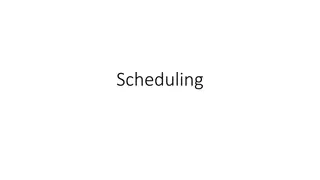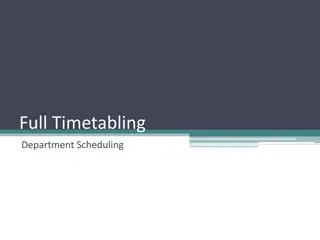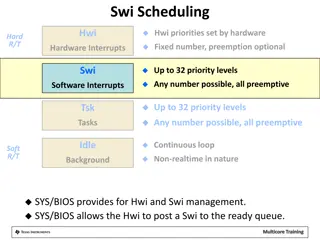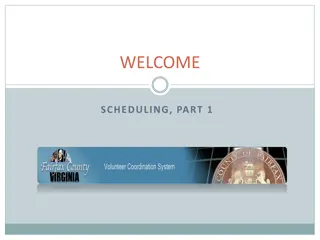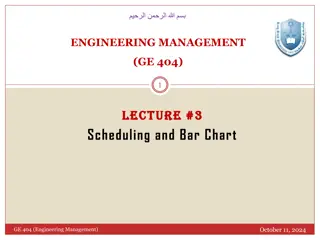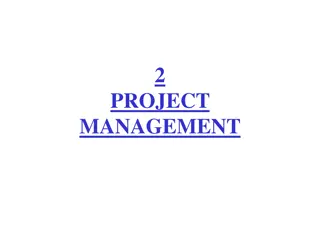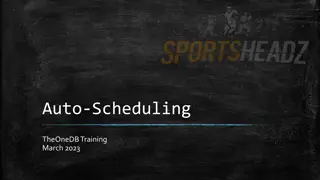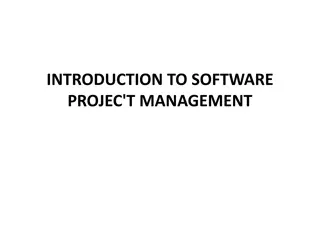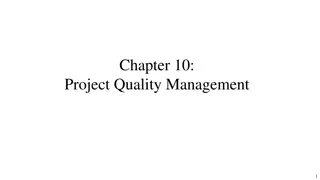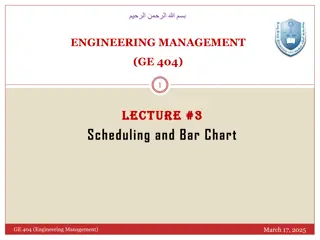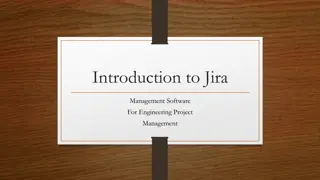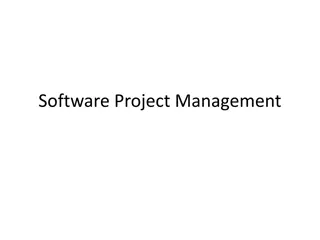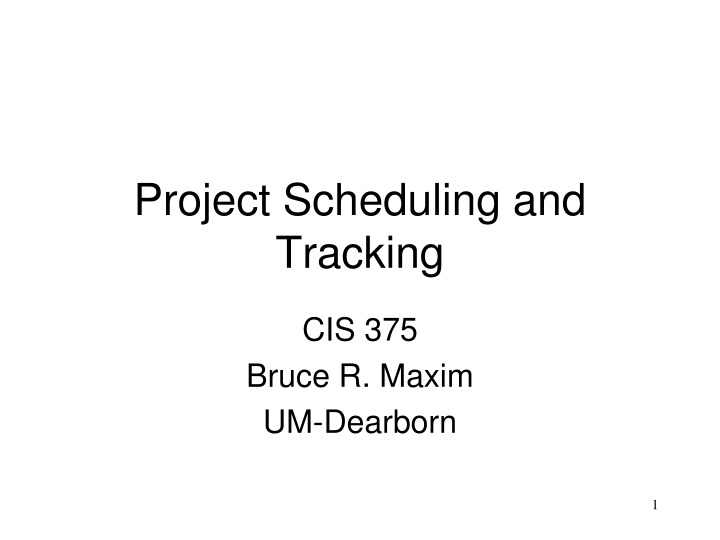
Project Scheduling and Tracking for Efficient Software Management
This project focuses on providing a structured framework for software managers to estimate resources, costs, and schedules effectively. It emphasizes updating estimates as the project progresses and aligning outcomes with best and worst-case scenarios. Key aspects include planning objectives, scope definition, product feasibility, customer needs assessment, and team organization strategies.
Download Presentation

Please find below an Image/Link to download the presentation.
The content on the website is provided AS IS for your information and personal use only. It may not be sold, licensed, or shared on other websites without obtaining consent from the author. If you encounter any issues during the download, it is possible that the publisher has removed the file from their server.
You are allowed to download the files provided on this website for personal or commercial use, subject to the condition that they are used lawfully. All files are the property of their respective owners.
The content on the website is provided AS IS for your information and personal use only. It may not be sold, licensed, or shared on other websites without obtaining consent from the author.
E N D
Presentation Transcript
Project Scheduling and Tracking CIS 375 Bruce R. Maxim UM-Dearborn 1
Planning Objectives To provide a framework that allows a software manager to make an estimate of resources, cost, and schedule. Project outcomes should be bounded by 'best case' and 'worst case' scenarios. Estimates should be updated as the project progresses. 2
Scope Definition Determine the customer's overall goals for the proposed system and any expected benefits. Determine the customer's perceptions concerning the nature of a good solution to the problem. Evaluate the effectiveness of the customer meeting. 3
Product Feasibility Technical feasibility is not a good enough reason to build a product. The product must meet the customer's needs and not be available as an off- the-shelf purchase. 4
What does the customer want to know? Do you understand my needs? Can you design a system to help me? How long will it take? How much will it cost? 5
People and Effort Adding people to a project after it is behind schedule often causes the schedule to slip further The relationship between the number of people on a project and overall productivity is not linear (e.g. 3 people do not produce 3 times the work of 1 person, if the people have to work in cooperation with one another) The main reasons for using more than 1 person on a project are to get the job done more rapidly and to improve software quality. 6
Matching People to Tasks (Myer-Briggs) 8
Software Team Organization Democratic decentralized rotating task coordinators group consensus Controlled decentralized permanent leader group problem solving subgroup implementation of solutions Controlled centralized top level problem solving internal coordination managed by team leader 9
Democratic 11
Factors Affecting Team Organization Difficulty of problem to be solved Size of resulting program Team lifetime Degree to which problem can be modularized Required quality and reliability of the system to be built Rigidity of the delivery date Degree of communication required for the project 12
Process Framework activities populated with Tasks milestones Work products Quality Assurance points 13
Framework Activities Customer communication Planning Risk analysis Engineering Construction and release Customer evaluation 14
Process Considerations - 1 Process model chosen must be appropriate for the: customers developers characteristics of the product project development environment Project planning begins with melding the product and the process 15
Process Considerations - 2 Each function to be engineered must pass though the set of framework activities defined for a software organization Work tasks may vary but the common process framework (CPF) is invariant (e.g. size does not matter) Software engineer s task is to estimate the resources required to move each function though the framework activities to produce each work product 16
Managing the Project Start on the right foot Maintain momentum Track progress Make smart decisions Conduct a postmortem analysis 17
Critical Practices Formal risk management Empirical cost and schedule estimation Metric-based project management Earned value tracking Defect tracking against quality targets People-aware program management 18
Scheduling Principles - 1 Compartmentalization the product and process must be decomposed into a manageable number of activities and tasks Interdependency tasks that can be completed in parallel must be separated from those that must completed serially Time allocation every task has start and completion dates that take the task interdependencies into account 19
Scheduling Principles - 2 Effort validation project manager must ensure that on any given day there are enough staff members assigned to completed the tasks within the time estimated in the project plan Defined Responsibilities every scheduled task needs to be assigned to a specific team member 20
Scheduling Principles - 3 Defined outcomes every task in the schedule needs to have a defined outcome (usually a work product or deliverable) Defined milestones a milestone is accomplished when one or more work products from an engineering task have passed quality review 21
Step 1 List the Deliverables Documents. Demonstration of function. Demonstration of subsystem. Demonstration of accuracy. Demonstration of reliability, security, or speed. 22
Step 2 Define the Milestones Completion of an activity or deliverable (must be measurable). Activities must have definite a start and stop. A milestone is point in time not a time period like an activity. 23
Step 3 Work Breakdown Structure Create the work breakdown structure (task network) Separate the project into phases composed of steps Subdivide steps into activities as needed 24
Project Effort Distribution Generally accepted guidelines are: 02-03 % planning 10-25 % requirements analysis 20-25 % design 15-20 % coding 30-40 % testing and debugging 25
Defining a Task Set Consider project type. Degree of rigor. Review rigor adaptation criteria. Determine task selector value. Consider concept development tasks. 26
Software Project Types - 1 Concept development initiated to explore new business concept or new application of technology New application development new product requested by customer Application enhancement major modifications to function, performance, or interfaces (observable to user) 27
Software Project Types - 2 Application maintenance correcting, adapting, or extending existing software (not immediately obvious to user) Reengineering rebuilding all (or part) of a legacy system 28
Software Process Degree of Rigor - 1 Casual all framework activities applied, only minimum task set required (umbrella activities minimized and documentation reduced) Structured all framework and umbrella activities applied (SQA, SCM, documentation, and measurement tasks are streamlined) 29
Software Process Degree of Rigor - 2 Strict full process and umbrella activities applied (high quality products and robust documentation produced) Quick reaction emergency situation, process framework used, but only tasks essential to good quality are applied (back filling used to develop documentation and conduct additional reviews after product is delivered) 30
Rigor Adaptation Criteria Maturity of applicable technology Performance constraints Embedded/non- embedded characteristics Project staffing Reengineering factors Size of project Number of potential users Mission criticality Application longevity Requirement stability Ease of customer/developer communication 31
Activity Graph Each activity has: 1. Precursor 2. Duration 3. Due date 4. End point (milestone or deliverable) 32
CPM Critical Path Method http://groups.umd.umich.edu/cis/tinytools/cis375/f00/cpm/CPM(1).HTM 33
Activity Precursor Duration EST EFT LST LFT Slack Start - 0 0 0 0 0 0 A Start 2 0 2 0 2 0 B Start 3 0 3 4 7 4 C A 5 2 7 2 7 0 D A,B 4 3 7 7 11 4 E D 2 7 9 11 13 4 F B,C 6 7 13 7 13 0 FINISH E,F 0 13 13 13 13 0 EST = earliest start time, EFT = earliest finish time. LST = latest start time, LFT = latest finish time. Slack = (LST - EST) or (LFT - EFT). 34
CPM Equations EST(START) always = 0, EFT(START) always = 0. LST(START) always = 0, LFT(START) always = 0. EFT(I) = EST(I) + DUR(I). EST(I) = max(EFT of all predecessors). LST(I) = LFT(I) - DUR(I). LFT(I) = min(LST of all sucessors). LFT(FINISH) = LST(FINISH) = EST(FINISH) = EFT(FINISH). Critical path is all nodes with Slack = 0. 35
Program Evaluation and Review Technique JAN FEB TASK EARLIEST START LATEST START 1 8 15 22 29 5 12 17 24 1 1/1 2/5 * * * * * * 2 1/1 1/8 * * 3 1/9 1/22 * * * * 4 1/9 1/22 * * * * 5 1/23 2/1 * * * 6 1/23 2/1 - - F 7 1/23 2/17 - - F F F 8 2/2 2/17 * * * * 36 * = critical activity, - = non-critical, F = float or slack
Gantt Chart 37
Overlay Resources on Gantt Chart 38
Line Graph 40
Earned Value Analysis Earned value is a quantitative measure of percent of project completed so far. The total hours to complete the entire project are estimated and each task is given an earned value based on its estimated percentage contribution to the total. http://groups.umd.umich.edu/cis/course.des/cis525/js/f00/tejal/form.htm 41
Error Tracking Allows comparison of current work to past projects and provides a quantitative indication of the quality of the work being conducted. The more quantitative the approach to project tracking and control, the more likely problems can be anticipated and dealt with in a proactive manner. 42



